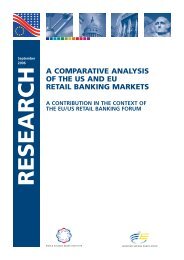Corporate Governance and Access to Finance - ESBG
Corporate Governance and Access to Finance - ESBG
Corporate Governance and Access to Finance - ESBG
You also want an ePaper? Increase the reach of your titles
YUMPU automatically turns print PDFs into web optimized ePapers that Google loves.
This list of <strong>to</strong>pics is intended <strong>to</strong> provide a general view of the mainmechanisms that connect <strong>Corporate</strong> <strong>Governance</strong> <strong>and</strong> <strong>Access</strong> <strong>to</strong> <strong>Finance</strong>.In doing so, the experience of the five case studies – <strong>and</strong> also other WSBImembers – is used as an example when relevant.2.1. <strong>Access</strong> <strong>to</strong> <strong>Finance</strong> missionFor most WSBI members, their objectives are well summarized in the“double bot<strong>to</strong>m line”: playing a role in the social <strong>and</strong> economicdevelopment of the local community, including through the provision of<strong>Access</strong> <strong>to</strong> <strong>Finance</strong> <strong>to</strong> unbanked/vulnerable segments of the population,<strong>and</strong> ensuring the long term sustainability of the institution through anadequate profitability. The link between <strong>Corporate</strong> <strong>Governance</strong> <strong>and</strong><strong>Access</strong> <strong>to</strong> <strong>Finance</strong> should seek ensuring management accountability asregards the financial inclusion objective. A pre-requisite is the clarity inthe definition of the mission of the institution.A necessary element of any strong institution that promotes <strong>Access</strong> <strong>to</strong><strong>Finance</strong> is a clear <strong>and</strong> sustainable m<strong>and</strong>ate, which should be revisedperiodically <strong>to</strong> ensure that the institution remains relevant <strong>and</strong> adapts<strong>to</strong> the changing market circumstances. Table 2 examines the missionstatements of the five WSBI members under study.Some examples of this clarity in the m<strong>and</strong>ate can be found in the PeruvianCMACs mission statement: “<strong>to</strong> benefit segments of the populationlacking financial support of traditional banking” (CMAC Arequipa) or “<strong>to</strong>provide financial services with efficiency, timeliness <strong>and</strong> competitiveness,both <strong>to</strong> small <strong>and</strong> micro enterprises (SMEs) <strong>and</strong> <strong>to</strong> families who normally donot have access <strong>to</strong> the banking system” (CMAC Piura). Another exampleis the Postal Bank of Kenya, whose mission includes “<strong>to</strong> provide accessible<strong>and</strong> sustainable banking <strong>and</strong> other related financial services”.The explicit reference <strong>to</strong> <strong>Access</strong> <strong>to</strong> <strong>Finance</strong> in the mission statement willserve as a basis <strong>to</strong> support financial inclusion efforts of the savings banks,mainly through the development of proximity banking activities thanks <strong>to</strong>an extended distribution network, <strong>and</strong> the offer of financial services <strong>and</strong>products tailored <strong>to</strong> the specific needs of underserved or unbanked people.24
















